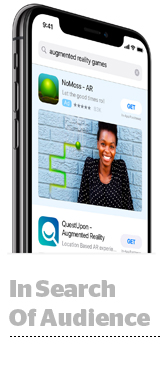
Search and ye shall find Apple search ads in six new markets.
Starting Wednesday, developers in France, Germany, Italy, South Korea, Spain and Japan will be able to run Search Ads Advanced in the Apple Store.
The product has been available in the US since 2016, and in the UK, Australia, New Zealand, Mexico, Canada and Switzerland since last year.
Apple search ads come in two flavors: advanced and basic. The advanced version offers pay-per-click pricing and the ability for advertisers to choose their own keywords and make their own targeting selections. Basic search ads are for indie developers with smaller budgets. They tell Apple what they want to pay and who they want to reach, and Apple makes the matches for them.
Basic is only accessible in the US for now but will expand to the same 13 markets as Search Ads Advanced on Aug. 22.
Despite forsaking its mobile ad platform iAd, which Apple shuttered in 2016, its App Store search ads business is reportedly worth nearly $1 billion. Admittedly, that pales in comparison to the more than $53 billion Apple generated in Q3, but it’s still nothing to sniff at.
Apple, which reported earnings Tuesday, posted $9.55 billion in services revenue, a growing business, which includes revenue from search ads.
It’s no wonder the App Store is becoming such a core piece of Apple’s ecosystem or that the company is tapping into advertising as an additional revenue stream, said Adam Fingerman, CEO and co-founder of Grey-owned app development studio ArcTouch.
“There’s a tremendous number of apps in the market, and it can be difficult to acquire users organically when you’re just launching,” he said. “Having a paid channel with high conversion rates will make this process easier.”
More than 70% of App Store visitors use search to find apps and 65% of all downloads are attributable directly to a search in the store, according to internal App Store data. The average conversion rate of a search ad in the App Store is around 50%.
Despite that performance, awareness is still low among some advertisers. Forrester analyst Collin Colburn said Apple Search Ads aren’t in high demand from the clients he speaks with.
“But there are definitely brands who have gained traction in app downloads and awareness of their apps by utilizing those ads,” Colburn said. “It’ll be interesting to see how international marketers will view App Store ads, because in many areas there just aren’t as many iPhone users as there are in the US.”
Targeting remains another question.
One of the main reasons iAd didn’t take off is because programmatic advertisers were less than impressed by the lack of targeting data.
Apple hasn’t changed its tune on the privacy front – in fact, it’s ramped up over the past few months, with additional tracking restrictions in Safari. But keyword-based targeting is a different animal. Advertisers can reach users who have demonstrated intent while Apple has the flexibility to maintain its privacy stance.
Although data from other Apple services – maps, Siri, iMessage, email, the health app or HomeKit – is not used to inform search ad targeting, there’s a lot of data that is fair game: App Store data, such as non-personal searches and the info developers provide to define and categorize their apps; first-party developer data collected through a direct relationship with the user; app transaction data, including which apps a user has downloaded; and contextual data, like device type, time of day and device location.
None of this data is used to build profiles on users or gets sold to third parties. It all lives within Apple’s walled garden. But app advertisers can still tap into the data to refine the audiences that see their ads within the App Store experience.
And Apple does also mete out some access to data through its search ads attribution API. Mobile measurement company Tune, for example, recently hooked into the API to ingest reinstall data to identify users that re-download an app after having deleted it.
This post was syndicated from Ad Exchanger.


More Stories
Daily Wire Welcomes Perplexity to Advertise on The Ben Shapiro Show
Here’s the Roundup for the Week Ending March 7
Aflac’s Dan Amos Reveals How He’s Successfully Held Onto the CEO’s Job for 35 Years